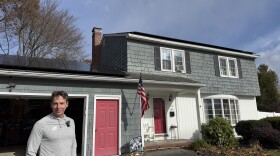Over the past century, heavy rainfall and snowstorms have grown more frequent and more severe in many parts of the U.S.—including the northeast—as a result of our warming climate. In a study published last month, researchers from Dartmouth College, University of Vermont, and Columbia University investigated exactly what those changes looked like here in New England.
Concord Monitor columnist David Brooks spoke with NHPR’s Peter Biello about the new study on this week’s Granite Geek.
You write in your column that the context to all this is a 2014 report called the National Climate Assessment. What did that report find, and how did it prompt this new study?
As the title suggests, it was trying to assess the climate and how it had changed over the whole country. So it broke things up into regions and it looked at various parameters over time. One of the things it found was that extreme precipitation events had increased in most of the country and had increased more in the northeast than elsewhere.
And when we talk about extreme precipitation events, what exactly does that mean?
Well the definition can vary slightly, but for the study we’re about to talk about, the definition is 2 inches of precipitation or more in a 24-hour period—which is a lot. We had a ton of rain last week, and I got 1.2 inches over a 24-hour period. Could be rain, could be snow melted down to water, could be hail I suppose.
So they looked at that, and the northeast had more [increase in precipitation than the rest of the country], so some researchers at Dartmouth, Columbia, and the University of Vermont said let’s look at it more closely, because if we just look at the northeast, we can parse the data more closely.
They gathered historical precipitation data from almost 5,900 weather stations all around the northeast, and their definition of the northeast extends clear down to West Virginia, and they looked at what had happened over time.
They found that yes indeed, the number of extreme precipitation events had increased over basically the last century, starting about 1910. But, what was odd is that they didn’t increase very much at all until the middle of the 1990s, and then it jumped.
Any sense as to why?
No—this is your classic good science. Good science generates more questions than it produces answers.
You’re right, the question is obviously, what the heck happened, and then why did it happen?
Can you give us a sense of what this change felt like to someone living in the affected areas?
Anecdotally, we all kind of know it. It feels like there have been more flooding events
This is flooding events, not the total amount of rain you get over the course of the year. If there’s a drought, like we had last year, that would drop the average. Then if you get a flood, like an Irene, that is what we’re talking about, large events that wash out culverts, overrun your roads, and flood fields.
My joke is that umbrellas became more necessary as of 1995, but to a certain extent that might not be true, because we might not be having much more rain total if we’re having more extreme dry spells in between the extreme rain—it’s definitely extreme weather that all the models indicate is likely to increase, although it’s increasing in an unexpected way.
Do the researchers assert that this is due in part to climate change?
No, they’re being very careful about that, it’s too early there. What they’re really trying to do is improve their climate models.
Critics will say, you can prove anything with climate models, as you write in your column.
Right, and you can prove anything. But climate models are very good—you and I use climate models and weather models every single day. When I was a kid, nobody knew what the weather was going to be like in 2 days. Now, I can look at a phone—I get mad if it can’t tell me whether it’s going to rain in an hour. That’s all due to climate modeling.
So, they want to use this information to create a better climate model to know what’s going on in the future. They’re going back now and looking at data about what was happening in the atmosphere around the mid-90s. Was there some change in the jet stream, was there some change in low-pressure systems down in the Caribbean that pushed tropical storms up north? Things like that.
That kind of information can be used in big-picture climate models, and that percolates down to what changes we’re more likely to see in the future.
The more information you can get, the more interaction, the more you can understand about [the climate]. This is an indication of why the climate, and climate change, is such an incredibly difficult thing to measure and to predict.
You and I, we’re laymen, we would think that, you know, there’s a little more greenhouse gas in the atmosphere every year, so things are going to get a little warmer, a little wetter every year, and we’ll just slowly march up.
But that’s not at all what happens. It doesn’t change for a while and then it suddenly leaps, for some reason, because there’s an interaction in the background that we don’t understand. So, the more information we get, the more we can predict this weird, jumping-up-and-down, changing system that is the climate, and which is going to make life interesting in decades to come.








